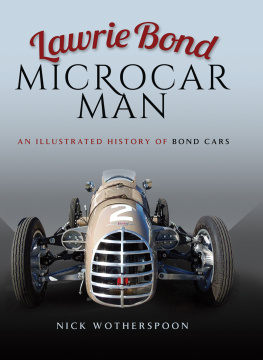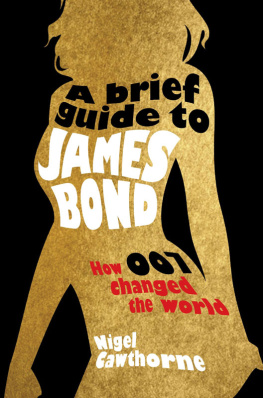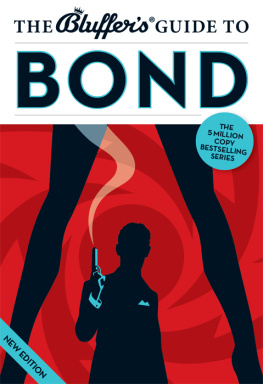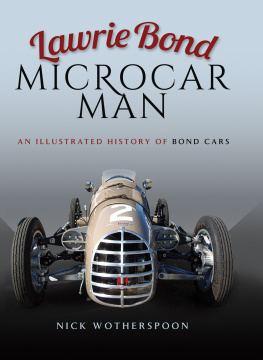
LAWRIE BOND
MICROCAR MAN
LAWRIE BOND
MICROCAR MAN
An Illustrated History of Bond Cars
Nick Wotherspoon
First published in Great Britain in 2017 by
Pen & Sword Transport
an imprint of
Pen & Sword Books Ltd,
47 Church Street,
Barnsley,
South Yorkshire
S70 2AS
Copyright Pen & Sword Books Limited, 2017
A CIP record for this book is available from the British Library.
ISBN 978 1 47385 868 8
eISBN 978 1 47385 870 1
Mobi ISBN 978 1 47385 869 5
The right of Nick Wotherspoon to be identified as the Author of this Work has been asserted by him in accordance with the Copyright, Designs and Patents Act 1988.
All rights reserved. No part of this book may be reproduced or transmitted in any form or by any means, electronic or mechanical including photocopying, recording or by any information storage and retrieval system, without permission from the Publisher in writing.
Pen & Sword Books Ltd incorporates the Imprints of Pen & Sword Aviation,
Pen & Sword Maritime, Pen & Sword Military, Wharncliffe Local History,
Pen & Sword Select, Pen & Sword Military Classics and Leo Cooper.
For a complete list of Pen & Sword titles please contact:
Pen & Sword Books Limited
47 Church Street, Barnsley, South Yorkshire S70 2AS, England
E-mail:
Website: www.pen-and-sword.co.uk
Dedication
This book is dedicated to my late dear friend Martin D. Whittaker, a truly gifted hands-on engineer who could turn his skills to almost anything and with whom I spent many happy hours developing my obsession for old cars.

Lawrence Lawrie Bond in a rare pose for the camera at Shelsley in 1951 in his Type C 500cc Racing Car.
Acknowledgements
Over the years I have been extremely fortunate to have had the support of many individuals without whom I would not have been able to complete either my initial 1993 work on Lawrie Bond and the machines connected with him, or this new book. I would like to thank everyone who has helped me with my research by providing me with advice, information, photographs or other documentary material. Special thanks go to those who have given me a personal insight into the life and work of the enigmatic Lawrie Bond, though sadly a number have passed away in the intervening years and from them I now only have the detailed notes I kept at the time. I am especially grateful to: Mrs Pauline Stephenson, Miss Viki Bond and Mr Raymond Bristo. Also to Mr R. Robinson, Mr P. Patterson, Mr Jon Goddard-Watts, Mr Jon Derisley, Mr B. Parkins, Mr Chris Featherstone, Mr Rowland Eastham and Ms Islene Walsh.
I would like to thank the following former employees of Sharps Commercials/Bond Cars Limited for their contributions and patience, again some have now passed away: Mr Alan Pounder, Mr John Woods, Mr Jim Kenyon, Mr Roy Atkinson, Mr Tom Gratrix and especially to the late Colonel C.R. Gray, whose excellent commentary on his part in the story of Bond Cars formed the foreword to my previous work and is included in this book for its historical merit.
I would also continue my thanks to the following for all their help, photographs, loan of material, access to vehicles, etc: Jean Hammond, Guy Singleton (Bond Equipe Register secretary, TSSC), Bruce Pilbrough (former Bond Equipe Register secretary, TSSC), Peter Jacklin (TSSC), Chris Gardner, Robert Buckby (BOC), Martin Boddy (Bug Club), Mike Costigan (TSSC), Nigel Halliday (Berkeley Enthusiasts Club), Stan Cornock (BOC), Nick Manders (BOC), Nick Kelly (VMCC), Duncan Rabagliati (Five Hundred Owners Association), Bernard Cowdrey, Don Pither, Gordon Hill, Cliff Ray, Peter G. Reed, David Crawford, Jim Bassett, Ian Gibson, T. Rowe, Peter Williams and the National Motor Museum Archives. Alan Currans (The Acceleration Archive), Mike Shepherd, Tom Karen, David Ratner, Robin Spalding, Andrew Argyle, Eric Antony Watkiss, Harry Kraemer, Roger Phillips, Roy Jaggar, Christian Knnecke, Bob Purton, Sascha Fillies (PS.SPEICHER, Einbeck), Dermot Elworthy, Andrew Tart, Rhona Bell, Tim Monck-Mason, Marty Richardson, Charlie Banyard Smith, Alan Waring, Geoff Toyer (BEC), Dave Perrin (BEC), Ian Harrop (VMSC), Clive Stanley, Thomas Touw, Ron Biggin, Lesley Cook, Justin Scratch Platts, Mike and Paula Cooper, Adam Turpin, and Clive and Andrea Steggel.
Finally, I give my thanks to all the writers responsible for the various books and journal articles that I have consulted during my research. I have tried to include details of more substantial works within the text where possible. My apologies to anyone I may have omitted.
Nick Wotherspoon, 2017
Foreword
My father Lawrence Bonds car designs were way ahead of their time. He was always thinking of his next design and if he wasnt at his drawing board working, he had paper and pencil at hand. As a child, some of my happiest memories of my father are when we were at the races and motor shows.
Though how I came to love motor racing so much is an enigma, as my first experience was very frightening. I was with my father and step-mother Paula in the pits. I cant remember if it was Goodwood or Brands Hatch (?) Anyway, a car came in and promptly burst into flames, only a few feet away. I was so scared I was shaking like a leaf. My father gave me a drink from his hip flask to help with the shock, saying to only take a tiny sip. Obviously I knocked it back. I have hated the smell of whisky ever since!
Then there were the Motor Shows at the Olympia Exhibition Hall, Earls Court Exhibition Centre, and the Racing Car Show at the Royal Horticultural Hall, Westminster. I just loved being on the stands, meeting all the famous racing drivers and celebrities of the day, as my father was always in demand and very much admired by them. Mind you, he was also a very quiet and shy man, and at the end of the day, to me, he was just my dad.
Viki Bond 2016
Prologue
Written in 1993 by the late Colonel C.R. Gray MBE TD CBIM
The year 1948, following closely upon the ending of the war in Europe and the Far East, brought with it many problems for industry throughout Great Britain. During this transitional period from wartime production to the requirements of everyday life there were shortages of just about everything needed by the manufacturing industry, and much of what was required was rationed. Steel could only be obtained on licence and to obtain a licence it was necessary to show that it was required for the manufacture of goods for export, in order to help the appalling state of the economy which prevailed after six years of war. Petrol was severely rationed, as were many other basic materials and those which were not officially rationed were rigidly controlled by their suppliers in an endeavour to share out what was available. Most of these supplies, naturally enough, went to their established customers.
This was the situation in which we at Sharps Commercials Limited found ourselves when we were notified by the Ministry of Supply, for whom we had been rebuilding military vehicles, that our contract would come to an end later in the year as by then what was left of the Armed Forces were fully equipped with new or rebuilt vehicles and no more would be required. It was at this point in time that I was approached by Lawrie Bond, a meeting which led to the introduction of the Bond Minicar and to the pioneering of ultra-lightweight motoring, subsequently to be followed by manufacturers with such familiar names as Heinkel and Messerschmitt, and a host of others who were not so successful. In retrospect, and with the hindsight of business knowledge acquired over the years since 1948, our decision to proceed with the introduction and manufacture of the Bond Minicar was indeed an optimistic and perhaps a bold one for all the odds were against us, but we were a young team filled with enthusiasm and prepared to work hard for long hours in order to achieve our objective.













